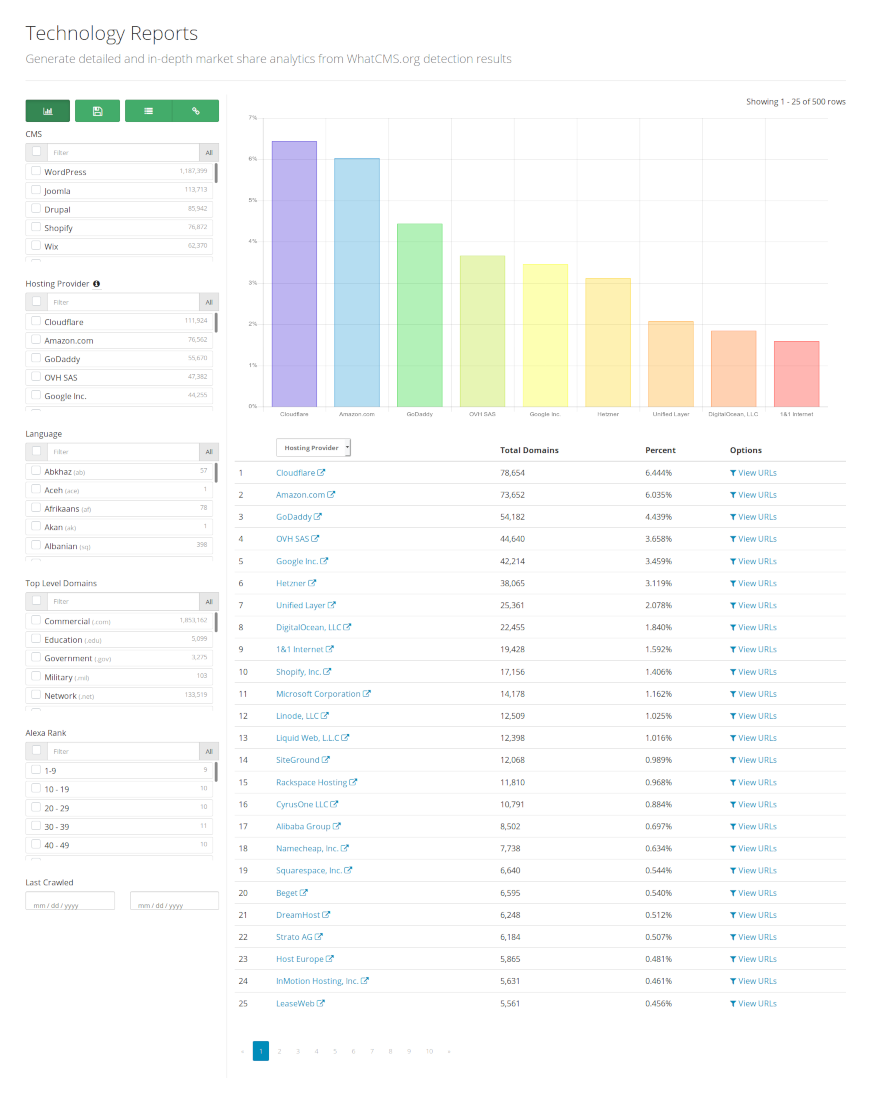Simpleview CMS
Thanks to an anonymous suggestion, we've added detection methods for Simpleview CMS. As is the case with any newly added CMS, our statistics won't be indicative of Simpleview's actual market share for a little while. But, from the looks of Simpleview's alexa rating and twitter following, we'll be seeing a healthy share very soon.
Introducing Technology Reports
We've been collecting website data for years now, and until recently we only used that information to generate statistics about content management systems. With millions of records, we were a far cry from using our data to it's full potential.
Introducing our newest feature: Technology Reports.
The reporting feature was developed to give users better access to our crawling data and detection results. Multi-faceted filtering allows anyone to generate market share and technology comparison reports with ease. It's currently possible to filter results on the following data columns:
- Content Management System
- Hosting Provider (data from Who-Hosts-This.com)
- Language
- Top Level Domain
- Alexa Rank
- Last crawled date
The basic report gives users the total number of domains found per row and calculates the percentage share based on the total domains in the report. Reports saved by registered users are automatically updated regularly along with the rest of our data.
Beyond our basic report, users have the option of purchasing more detailed information. The dataset included in a purchased report is a complete url-by-url breakdown of WhatCMS and Who-Hosts-This detections. The data can be browsed and filtered further within our interface or downloaded as an Excel or Open Document spreadsheet.

Over 400 Content Management Systems
Updated Batch Detections
Our batch detections have been the easiest and most scalable way to detect content management systems for a large set of urls since we introduced the service in January. And we just made them even better.
Our initial batch detection system allowed users to upload urls and our system would run behind the scenes to process all of them and email the user once they were done. It worked great, but since the detections were happening behind the scenes, users often weren't sure if anything was happening at all. Additionally, since we had one system for processing batches, if two or more users uploaded urls around the same time, results would be delayed for the user who uploaded their urls last.
Our new system solves all of these problems and automatically maximizes the detection rate for each user so their batches finish as quickly as possible. It works nearly identically to the previous system, with one additional step required from the user: clicking "Start". Yep, that's it.
We hope you like the additional control and usability of the new system. And if you haven't tried it out yet, you can sign up for an API account here.
More Detections and Chrome Extension
It's a safe bet to assume we're always working on better detection methods. It's what we do, and when there are hundreds of different content management systems running millions web sites, there's always something to improve on.
The behind the scenes algorithms are only half the battle though and giving our users access to the detection results is just as important. Which is why we're proud to announce the release of our Google Chrome Extension. It's identical to our Firefox add-on, the biggest difference is that it's readily available for installation from the Chrome Web Store.
Firefox Add-on
We just released version 0.1 of our Firefox Add-on. The new add-on allows users to detect content management systems with the click of a button in the Firefox toolbar.

378 Content Management Systems
We're nearly up to 380 content management systems! We recently added detection methods for Contentful, SiteKreator and LeadPages. Since these are new system to WhatCMS.org, the market share calculations we have are artificially low. We expect, as we check and re-check more sites, their market share numbers to grow.
In addition to improving our detection coverage, we spent time beefing up our existing detection methods for BigCommerce, MantisBT. As with the new systems mentioned above, we may see the market share for these systems increase but we don't expect significant changes.
340 Content Management Systems
We just uploaded another update to our detection software. We've been pouring over web page content to beef up our detection algorithms and add to the list of detectable systems. Today's update brings us up to 340 different content management systems and better detection for a number of other systems.
Dedicated Content Management System Detection